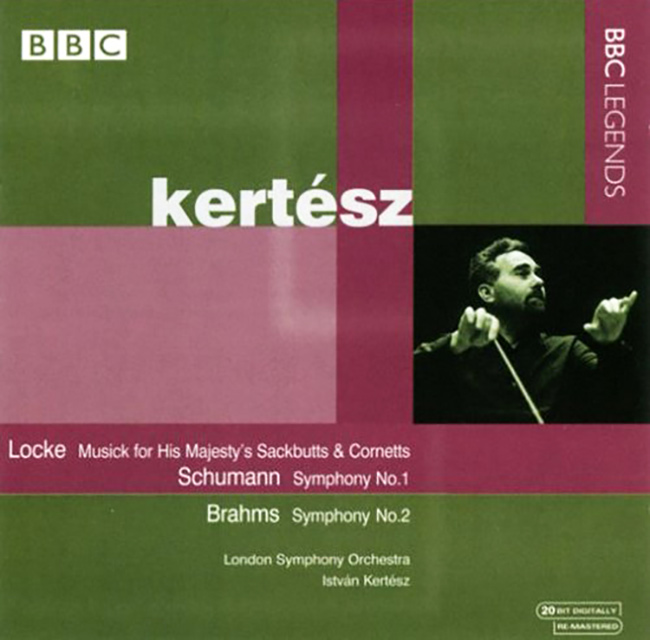Logowanie
Mikołaj - ten to ma gest!
Miles Davis, Horace Silver, Jay Jay Johnson, Percy Heath, Kenny Clarke, Lucky Thompson
Walkin'
20bit K2Super Coding - ale jak to brzmi!
Kasety magnetofonowe
Winylowy niezbędnik
ClearAudio
Double Matrix Professional - Sonic
najbardziej inteligentna i skuteczna pralka do płyt winylowych wszelkiego typu - całkowicie automatyczna
LOCKE, SCHUMANN, BRAHMS, The London Symphony Orchestra, Istvan Kertesz
Musick for His Majesty’s Sackbutts & Cornetts / Symphony No. 1 in B-flat Major / Symphony No. 2 in D Major, Op. 73
- The London Symphony Orchestra - orchestra
- Istvan Kertesz - conductor
- LOCKE
- SCHUMANN
- BRAHMS
Istvan Kertesz (1929-1973) enjoys a repute as a great talent tragically taken from us too soon, the victim of his own hubris, drowning in Israel even after having been warned of the dangers of the area. A pupil of Kodaly, Kertesz claimed to a kinship to both Otto Klemperer and Bruno Walter, and he ingested their romantic classicism as part of his musical personality. Barry Tuckwell, principal French horn of the London Symphony, recalled Kertesz fondly in an Atlanta interview, in which he spoke of “the favorite of the many visiting Hungarians who assumed the podium of the LSO.” Kertesz opens (15 February 1966) with virtuoso wind and brass music by Matthew Locke (1622-1677), a kind of solemn, ceremonial motet and suite of dances in six parts, resonant and rife with heraldic trills. The Schumann Symphony (30 November 1965), like Locke, is new to Kertesz’s discography: driven without exposition repeats, the music shimmers in luxuriant energies and lean, warm evocations of Nature’s bounty. Excellent oboe work in the course of the various dialogues of winds, plucked strings, flute, triangle, and tympani. Exuberant rocket figures culminate in the restatement of the main theme in jubilant horns, the string rockets rising and tumbling in playful dalliance. Bustling motion to one more annunciation of the main theme, at once dizzy and transfigured into a hymn of praise; the coda led by the flute, trumpets and whirling strings to a resolute declaration of pantheistic faith. That Kertesz can permit unbridled melody to sing without mannerism proves itself in the Larghetto, a paean of gentle power whose harmonies already point to the Rhenish Symphony. Good motion and graduated dynamics in the Scherzo, the tympani and trumpets again in bravura form. The last movement trips all spirit to its preconceived end, with ravishingly transparent colors from the flutes and horns, the strings’ tremolo building up considerable heat; then, the oboe, the French horns, and trilled flute renew the chugging theme to its lyrically swollen, supercharged climax. The crown roars triumphant. Brahms was a Kertesz specialty: he recorded the D Major with the Vienna Philharmonic in 1964. This performance (15 February 1966) relishes the opening Allegro non troppo’s undercurrents in double bass, cellos, and violas, the oboe, upper strings and flute parrying until the long cello line throbs forward in lush harmony. Romantic and pastorally dramatic, the realization urges the influence of Bruno Walter, certainly, but exuding a definite eroticism endemic to Kertesz. Eschewing the repeat, the music insists on its own passions without sacrificing breadth of conception, the horn-work brilliant, the strings and tympani Herculean. Lush transitions to the recapitulation, the thunder relinquished to the autumnal song of the cellos and flutes once more. The Adagio casts a tragic mood, only intermittently broken by sunshine. It moves under a steady compulsion, elegiac, impassioned, tender and resigned. The lovely oboe sings as part of a wind serenade for the Andantino, the strings rising and then scampering to a fertile crescendo and the Trio. Dark strings and winds bring us back, da capo, to a warm, lyrical surface whose deeps suggest an unquenchable longing. Kertesz invokes a veritable explosion for the Allegro con spirito finale, the woodwinds percolating over animated, undulant strings. Much of the development sounds like the Tragic Overture; Kertesz urges the music forward through its fitful stops and starts. The hard-won resolution comes in stages, passing through woodwinds, horns, flutes, then tutti with strings, a surging tempest, punctuated by flaring trumpets and tympani, the thunderbolts moving several audience members to a premature volley of applause. — Gary Lemco































